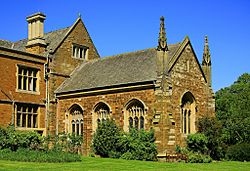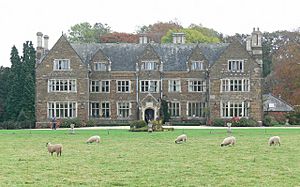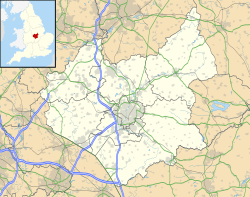Launde Priory facts for kids

The remains of Laude Priory were incorporated into the chapel of the newly constructed manor house known as Launde Abbey
|
|
| Monastery information | |
|---|---|
| Order | Augustinian Canons Regular |
| Established | c.1119 |
| Disestablished | 1538 |
| Dedicated to | St John the Baptist |
| Diocese | Lincoln |
| People | |
| Founder(s) | Richard and Maud Basset |
| Site | |
| Coordinates | 52°37′51″N 0°49′25″W / 52.630971°N 0.82371°W |
| Visible remains | Incorporated into the chapel of Launde Abbey Manor House. |
Launde Priory was an Augustinian priory, a type of religious house, located in Leicestershire, England. Today, the site is known as Launde Abbey. It serves as a special place for meetings and spiritual retreats. It is used by the Church of England dioceses of Leicester and Peterborough.
Contents
History of Launde Priory
Founding and Early Growth
Launde Priory was started around the year 1119. It was founded by Richard Basset and his wife, Maude. They gave the priory many gifts to help it grow. These gifts included the rights to choose priests for several churches. This right was called an "advowson."
The churches were in places like Ab Kettleby, Frisby on the Wreake, and Oadby in Leicestershire. They also received rights to churches in Northamptonshire, Derbyshire, Nottinghamshire, Rutland, and Staffordshire. The founders also gave the priory the village of Loddington.
Over the next 50 years, the priory received more churches from other generous people. These included churches in Grimston and Tilton in Leicestershire. The priory also gained the manor of Frisby-on-the-Wreake. This land was taken by King Henry II for a short time. However, it was later given back to the priory.
In the following century, Launde Priory continued to gain more churches. Some of these were in Ashby Folville and Peatling Parva in Leicestershire. Others were in Arthingworth and Little Bowden in Northamptonshire.
Challenges and Decline
Even with all its property, the priory did not keep everything it gained. It lost many of its possessions over time. This happened for different reasons throughout its history.
Around the mid-1400s, a church leader named William Alnwick, who was the Bishop of Lincoln, visited the priory. His visit showed that the priory was facing problems. There were only 10 canons (religious men) living there, but before, there had been 18.
The priory's income had also dropped a lot. It went from a large amount of money to much less. These issues were believed to be caused by some leaders who managed the priory poorly. This period of decline continued for many years.
By 1528, records showed that the priory had a prior (the head of the priory), 9 canons, and 4 novices (new members). However, the buildings were in bad shape. The refectory, which was the dining hall, was in ruins. The priory church itself was also "dilapidated," meaning it was falling apart.
Dissolution and New Beginnings
In 1535, a financial survey called the Valor Ecclesiasticus was done. It reported that Launde Priory had an annual income of about £400 after all its expenses.
The priory was finally closed down in December 1539. This was part of a larger event called the Dissolution of the Monasteries. The prior, who was the head of the priory, was given a yearly payment of £60.
Thomas Cromwell, a very powerful advisor to King Henry VIII, had been interested in the priory's land since 1528. After the priory was closed, he made sure the property was given to him.
Cromwell then built a new manor house on the site of the old priory. This new house is what we know today as Launde Abbey. A part of the old priory church was kept and made into a new chapel. This chapel was attached to Cromwell's new house.

Gregory Cromwell, 1st Baron Cromwell, who was Thomas Cromwell's son, was buried in that chapel.


